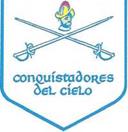TWA Miscellany
|
(picture courtesy Richard and Bernice DeGarmo, Al’s son, and daughter-in-law) |
Air Mail Special
One of the more unusual of T. W.A.’s “firsts”is that, of all the airlines established in 1925 as the result of the Kelly Air Mail Act, it carried the first passenger. He was not even the official recipient of Western Air Express’s ticket No. 1 (see page 6) but he did precede Mr. Ben Redman, who had that privilege. Not only was Will Rogers the first passenger in T. W.A.’s 75-year history, he was the first famous personality of the dozens of celebrities who were later to make Howard Hughes’s company the Airline of the Stars.
The civil air mail regulations required that, before an airline could carry passengers, it had to carry the mail for 90 days, or at least for a trial period (see page 9). A1 DeGarmo, one of the Western’s legendary Four Horsemen (see page 10), was a friend of Will Rogers, then a vaudeville entertainer, noted for his prowess with rope tricks, later to become famous for his droll commentaries on the human condition. In a conspiracy that evaded the law — the lawyers would have had a lovely time in the courts — Will stuck a quantity of stamps on the back of his jacket and mailed himself to Salt Lake City and back.
In 1926, the pilots were not noted for their sartorial elegance, as they are today. But their attire was practical, and included a side-arm. This was to guard the mail, and in this case, presumably, to guard Will Rogers as well.
Los Conquistadores del Cielo
Another of T. W.A.’s lesser-known “firsts’ is that it inspired the foundation of that exclusive aviation club. The idea originated when in 1937 the airline obtained widespread support among political and business circles for its cut-off route to San Francisco, branching off northwestwards from Winslow, thus avoiding the circuitous route via Los Angeles and a connection on to Western Air Lines, via Las Vegas (see page 38).
President Jack Frye wanted to make a token reward to all the influential supporters who had enabled him to win approval for this important access to San Francisco. John Walker, Frye’s vice-president, suggested a weekend celebration in September 1937 for 60 guests at the Forked Lightning Ranch in Albuquerque. A great time was had by all, including horseback riding, fishing, and a dude rodeo — at which Jack Frye showed that he was no mean hand at roping steers, at least small steers.
The general consensus was “let’s do it again.” and John Walker once again came up with the idea of linking an annual event with the Spanish tradition of the south-western states, the locale of the cut-off route. And so was bom Los Conquistadores del Cielo, named after Francisco de Coronado, the Spanish conquistador who had annexed the whole area for Spain.
Jack Frye was elected president and 91 senior aviation aficionados were inducted on 16-18 September 1938 in a colorful initiation ceremony. This has been enhanced by a dress code, introduced by Walker in 1951: replicas of the raiment worn by Hernan Cortes and the original conquistadores. The Conquerors of the Skies meet every year, at different venues, in an elite association that owes its origins to a T. W.A. route extension.
|
(courtesy: Constance Walker) |
|
(courtesy: Ona Gieschen) |
Flooded Out
In July 1951, there was a great flood in the Missouri River valley, covering an extensive area of low-lying land around Kansas City, where the confluence with the Kansas River exacerbated the disaster. T. W.A.’s engineering base was then at the Fairfax airport (see page 107) which was vulnerable to flooding. In this picture a lone DC-3 can be seen stranded in the waters, but T. W.A. flew the other resident aircraft to higher ground.
|
(courtesy: Ona Gieschen) |
Historic Greeting
As narrated on page 52, one of the pivotal events in air transport history was the dramatic flight in 1944 of the first Lockheed Constellation, when Howard Hughes and Jack Frye delivered the prototype from Burbank to Washington in a transcontinental record time, (see page 52) They are pictured here on arrival at Washington’s National Airport with (left) William A. M.Burden, Assistant Secretary of Commerce; and Jesse Jones, Secretary of Commerce.
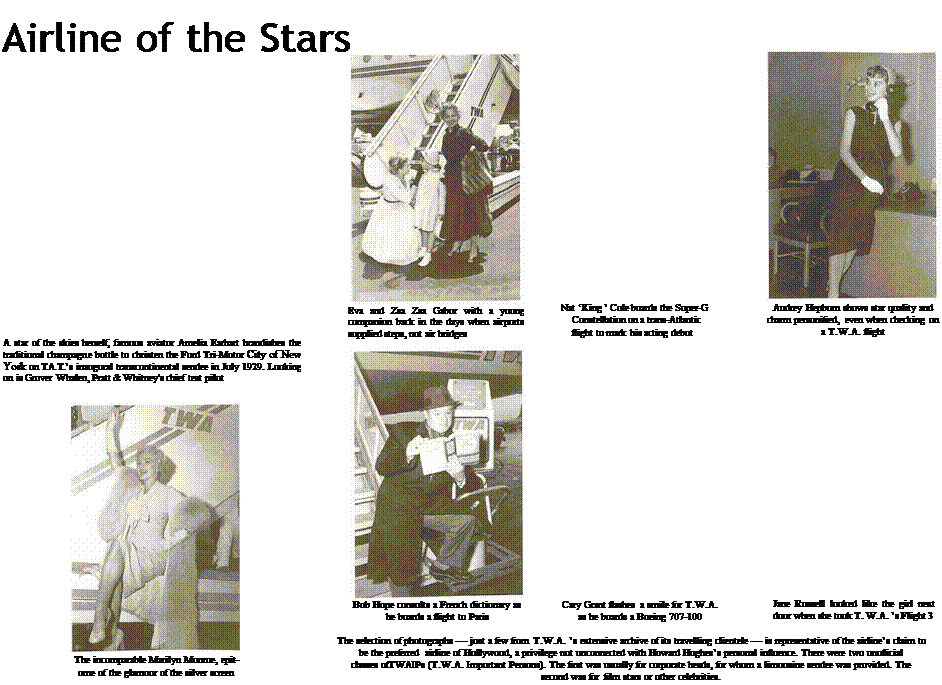

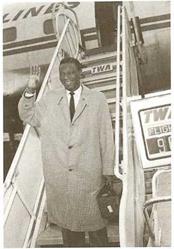
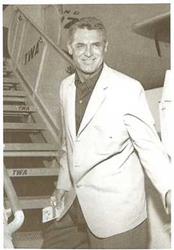
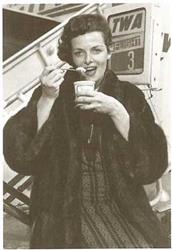
|
|












